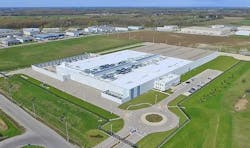Flexibility Creates Opportunity for Ascent Data Center Business
What’s your data center business model? Wholesale? Build to suit? Multi-tenant? Powered shell?
For Ascent Corp., the answer is “all of the above.” The St. Louis-based company has been building and operating data centers since 1998, providing a wide range of design, engineering, construction and maintenance services.
That versatility allows Ascent to be opportunistic as it expands its data center business, tailoring its approach to the needs of a particular facility or geographic market.
“Our strength is flexibility around the business model,” said Phil Horstmann, the founder and CEO of Ascent. “It’s always being in the right place at the right time.”
Expanding Through Sale/Leaseback
Ascent is now in growth mode, having recently acquired a pair of data centers in Atlanta and Waterloo, Ontario through through a sale/leaseback deal with an enterprise seller. “These are both great markets with lots of demand, and we were able to get two great facilities,” said Horstmann.
The sale/leaseback transaction, which closed in March, provides benefits for both parties. The seller gains revenue from the sale of the property, while continuing to use its infrastructure as a tenant. As landlord, Ascent gets rental income as well as the “value-add” upside from developing the unused capacity in both facilities and filling it with data center tenants.
Horstmann called the deal “a perfect complement to Ascent’s solutions set and its ability to deliver quickly on complex customer data center challenges.”
A History of Service Expansion
Horstmann founded Ascent to help customers manage and maintain mission critical equipment. The company soon expanded into engineering, construction services and data center staffing. In 2006 Ascent entered the wholesale market with a huge splash, building a 440,000 square foot speculative project in Northlake, Illinois, not far from Chicago’s O’Hare Airport. The facility was designed as a multi-tenant project, but Ascent leased the entire site to Microsoft, which filled the huge building with data center containers.[clickToTweet tweet=”Ascent CEO Phil Horstmann: Our strength is flexibility around the business model. #datacenter” quote=”Ascent CEO Phil Horstmann: Our strength is flexibility around the business model.”]
Ascent soon began building a second data center in Northlake, adjacent to the Microsoft building. The CH2 project became a multi-tenant wholesale facility, offering build-to-suit Dynamic Data Center Suites. Ascent’s design introduced unusual flexibility in partitioning the building for different configurations. Customers could lease a basic powered shell or a fully constructed turn-key space, and could choose between a raised floor or slab environment, chilled water or air-side cooling, or standard racks or container-based computing units.
Comcast became the anchor tenant at CH2, with several enterprise tenants following suit. In 2014, CH2 was acquired by Carter Validus Mission Critical REIT for $211.7 million. Ascent continues to manage CH2, and has five other data center projects:
- Atlanta: The ATL1 facility is a 185,000 square foot buildin on a 38-acre secure site in the Atlanta suburb of Alpharetta. A tenant occupies two data halls, but there is up to 8 MW of server-ready space, with the ability to add another 75,000 square feet of capacity if needed.
- Toronto: The TOR1 data center is a 270,000 SF building in Cambridge, Ontario between Toronto and the tech hub of Waterloo. It has multiple data halls, with 4.8 MW of capacity available. Ascent has the ability to expand the property’s power by as much as 75 megawatts to add more tenants. Some demand is likely to come from growth companies from the CommuniTECH incubator in Waterloo, which is also home to Blackberry.
- Dallas: The DAL1 facility ion the Dallas suburb of Plano is a retrofit of an existing enterprise data center. Ascent has 2.7 MW of capacity online and available for lease. Horstmann says the site is well-positioned in the competitive Dallas market. “There’s an awful lot of multi-tenant space, but not a lot of stand-alone product in the market,” he said. “Dallas continues to be an extremely hot market.” The property has expansion space for build-to-suit space for up to 6.6 MW of capacity for a cloud provider or enterprise tenant.
- St. Louis: Ascent has announced plans to build a greenfield data center in its home market of St. Louis. The company has a 15-acre site that can support a 10 megawatt data center.
- Downtown Chicago: Having built two successful projects in suburban Northlake, in 2013 Ascent announced a poject in Downtown Chicago, where it hopes to to renovate a property on South Desplaines Street in the South Loop as its CH3 data center. It plans to offer wholesale space using its Dynamics Data Center Suites deployment model.
Horstmann says these projects offer Ascent lots of runway for growth in key markets.
“We have turnkey capacity ready to go,” he said. “In this case of Dallas, Toronto and Atlanta we have a lot of flexibility due to the nature of the sites. Our differentiating quality is that we provide customized build-to-suit space.”
The sale/leaseback model is becoming a popular tool for data center providers seeking to expand. This strategy has been used by providers like H5 Data Centers, ByteGrid, T5 Data Centers and Lincoln Rackhouse. A growing number of enterprises are interested in these transactions, in which the sale of their data center raises cash while allowing continued use of the facility. Many enterprises, it seems, are not interested in owning and managing data center real estate. But not all are a good fit for data center specialists.
“There’s a lot of enterprise stuff out there in markets that are less desirable, or facilities that are not at the level they need to be,” said Horstmann. “There’s tons and tons of data centers out there. We’ll take it on a case by case basis.”
Ascent believes the cloud disruption, and its promise of a future with fewer on-premises data centers, .
“The business is rapidly changing,” said Horstmann. “The cloud continues to be very disruptive, but it creates a lot of opportunities for developers like us.”
About the Author



